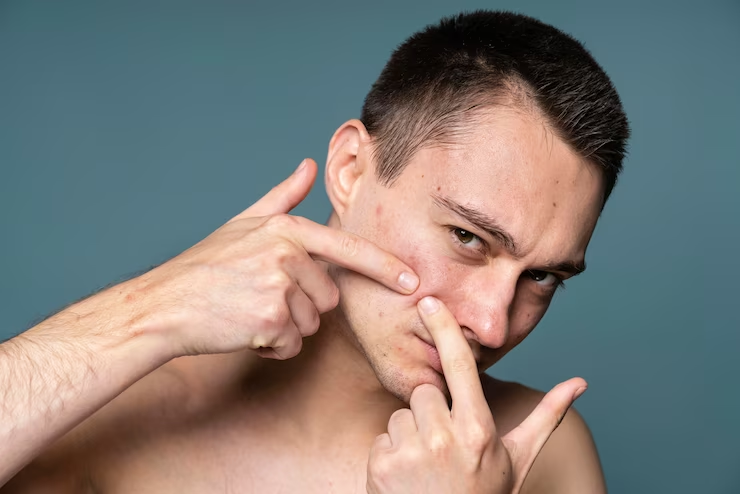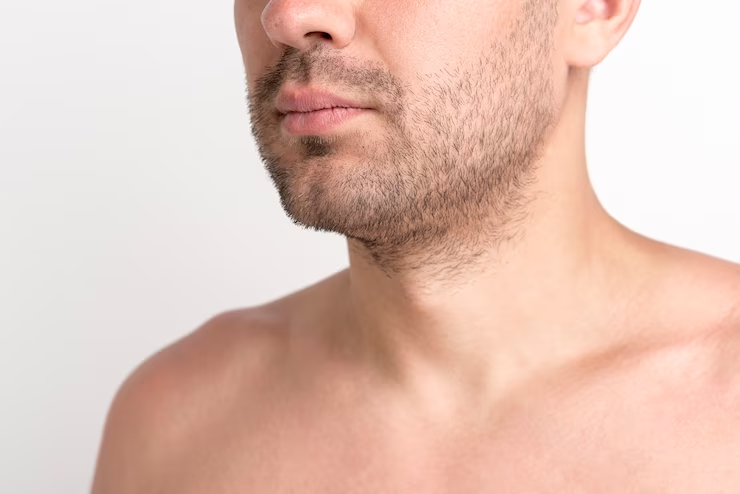
Are you familiar with those pesky little bumps that seem to appear out of nowhere on your skin? They're known as whiteheads, and they can be quite frustrating to deal with. While the urge to pop them may be strong, it's essential to approach whitehead extraction with caution.
In this comprehensive guide, we will delve into the world of whiteheads and explore the do's and don'ts of popping whiteheads. By understanding the risks involved and learning the proper techniques, you can effectively manage whiteheads without causing harm to your skin. So, grab a seat and let's explore the safest ways to address those stubborn whiteheads that have been bothering you.
What are whiteheads?

Source: https://my.clevelandclinic.org/-/scassets/images/org/health/articles/22039-whiteheads
Whiteheads, also known as closed comedones, are a common form of acne characterized by small, raised bumps on the skin's surface. They typically appear as white or flesh-colored papules with a small opening at the top, which is clogged with oil, dead skin cells, and other debris. Unlike blackheads, which have open pores and oxidized sebum, whiteheads are closed, giving them their distinct appearance.
Whiteheads form when excess oil (sebum) produced by the skin's oil glands combines with dead skin cells and clogs the hair follicles or pores. This blockage prevents the sebum and dead skin cells from reaching the surface of the skin, resulting in the formation of a small bump. The trapped sebum and bacteria within the follicle create a favorable environment for the growth of Propionibacterium acnes, a type of bacteria that contributes to acne development.
Whiteheads commonly appear on the face, particularly in areas with high sebum production, such as the forehead, nose, and chin. However, they can also occur on the chest, back, and other parts of the body.
Should I Pop Whiteheads At Home?

Popping whiteheads, while often seen as a quick solution, can have serious consequences if not done correctly. It may appear simple, but there is an art to it that requires proper technique. Popping huge whiteheads by yourself can backfire, leading to a range of negative consequences such as:
Permanent acne scars
Aggressively squeezing or picking at a pimple can cause damage to the surrounding skin tissue, leading to indentations, discoloration, or texture irregularities that may persist long after the pimple itself has healed.
Makes acne more noticeable
Forcefully extracting a pimple can push bacteria and sebum deeper into the skin, causing increased inflammation and extending the healing process. This can result in a more prominent and long-lasting acne lesion.
Worsens the pain
Improper techniques such as using dirty hands or applying excessive pressure can lead to increased irritation, redness, and discomfort. In some cases, it may even cause the pimple to rupture beneath the skin's surface, leading to a deeper and more painful cystic acne lesion.
Potential for infection
When you squeeze a pimple, you break the skin's protective barrier, providing an entry point for bacteria. This can result in an infected pimple or even the spread of bacteria to other areas of the skin, leading to more extensive breakouts.
When You Should NOT Pop Whiteheads

When it comes to whiteheads, which are a type of acne lesion, it's generally best to avoid popping them, particularly when they fall into these categories below. It's natural to wonder, "Should I pop whiteheads?" However, it's important to understand the reasons behind refraining from popping these types of whiteheads. Here's why you should refrain from popping these types of whiteheads:
Papules
Papules are red, inflamed bumps without a visible whitehead. Popping papules can lead to further inflammation, potential infection, and the risk of scarring. Instead, allow papules to heal naturally by practicing proper skincare and using appropriate acne treatments.
Pustules
Pustules are characterized by a visible white or yellow center of pus surrounded by red, inflamed skin. Although they may seem tempting to pop, doing so can introduce bacteria deeper into the skin, potentially spreading the infection. Popping pustules can result in increased inflammation, prolonged healing time, and an elevated risk of scarring. It's best to let pustules resolve on their own with proper care.
Nodules
Nodules are deep, painful, and often large acne lesions that develop beneath the skin's surface. Popping nodules at home can lead to further pain, increased inflammation, and a higher likelihood of scarring. It's crucial to seek professional medical assistance for appropriate treatment and avoid attempting to pop nodules yourself.
Cysts
Cysts are large, pus-filled bumps that are often painful to the touch. Trying to pop or squeeze cysts can cause severe pain, a higher risk of infection, and an increased chance of scarring. Instead, consult a dermatologist for proper evaluation and treatment of cystic acne.
Dermatologists' Techniques for Proper Whitehead Extraction

When it comes to dealing with huge whiteheads, seeking professional help from a dermatologist is the best course of action. Dermatologists are trained in performing proper whitehead extraction techniques, ensuring effective removal while minimizing the risk of complications. In this article, we will explore how dermatologists approach the extraction of large whiteheads, prioritizing patient safety and optimal results.
Popping huge whiteheads at home can be risky and may lead to undesirable outcomes. Dermatologists, equipped with their expertise and specialized tools, employ a professional approach to whitehead extraction that focuses on safety, minimizing scarring, and achieving the best possible results for their patients.
Before performing any extraction, dermatologists carefully examine the whitehead and surrounding skin. They assess the size, location, and underlying condition to determine the most appropriate technique for extraction. This evaluation helps them tailor the procedure to the individual's needs and minimize potential damage to the skin.
To ensure a sterile environment, dermatologists take precautions such as cleansing the area thoroughly and using sterilized instruments. They wear gloves to prevent the introduction of bacteria and reduce the risk of infection during the procedure.
One common technique dermatologists use for extracting whiteheads is gentle manual extraction. They use specialized tools, such as comedone extractors or sterile cotton swabs, to apply controlled pressure around the whitehead's edges. This technique allows the contents of the whitehead to be released without causing excessive trauma to the surrounding tissue.
For more complex or deep whiteheads, dermatologists may employ techniques such as incision and drainage. This involves creating a small incision with a sterile needle or scalpel to release the trapped contents. It is a meticulous procedure performed under sterile conditions to minimize scarring and reduce the risk of infection.
Following whitehead extraction, dermatologists often apply an antiseptic solution to the treated area. They may also recommend post-extraction care, such as applying a soothing cream or administering a treatment to reduce inflammation and prevent future breakouts.
Alternatives to Popping Whiteheads
When faced with the temptation of popping huge whiteheads, it's important to explore alternative methods that are both gentle and effective. Popping huge whiteheads can lead to complications, such as scarring and infection. By considering alternative approaches, you can address the issue without compromising the health and appearance of your skin.
Warm Compresses
Applying warm compresses to the affected area is a simple yet effective way to encourage whiteheads to naturally resolve without popping them. The heat helps to soften the skin, open up the pores, and promote the release of trapped sebum and debris. By using warm compresses, you can address whiteheads without the need for popping.
Salicylic Acid
Salicylic acid is a common ingredient in many acne treatments and can be an effective alternative to popping whiteheads. It works by exfoliating the skin, unclogging pores, and reducing inflammation. Incorporating products that contain salicylic acid into your skincare routine can help address whiteheads without resorting to popping them.
Benzoyl Peroxide
Benzoyl peroxide is another popular ingredient known for its acne-fighting properties and can serve as an alternative to popping huge whiteheads. It helps to kill bacteria, reduce inflammation, and remove excess oil. Applying benzoyl peroxide cream or gel to the affected area can help address whiteheads without the need for popping.
Topical Retinoids
Topical retinoids, such as tretinoin or adapalene, provide an alternative approach to popping whiteheads. These medications work by increasing cell turnover, preventing clogged pores, and promoting a smoother complexion. By incorporating topical retinoids into your skincare routine, you can effectively address whiteheads without the need for popping.
Self-care Tips to Manage and Prevent Whiteheads

In addition to alternative methods and professional treatments, there are several self-care tips you can follow to effectively manage and prevent whiteheads. Incorporating these practices into your daily routine can help keep your skin healthy and minimize the occurrence of whiteheads. Here are some self-care tips for managing whiteheads:
Maintain a consistent cleansing routine
Make it a habit to cleanse your face twice a day using a mild cleanser. This helps remove excess oil, dirt, and impurities that can contribute to the formation of whiteheads. Avoid harsh cleansers that can strip the skin and cause irritation.
Regularly exfoliate
Incorporate regular exfoliation into your skincare routine to slough off dead skin cells and unclog pores. Choose a gentle scrub or a chemical exfoliant with ingredients like salicylic acid or glycolic acid. However, be cautious not to overdo it, as excessive exfoliation can lead to irritation and more breakouts.
Opt for non-comedogenic products
When selecting skincare and cosmetic products, opt for those labeled as non-comedogenic. These products are specifically formulated to not clog pores, reducing the likelihood of whitehead formation.
Use an appropriate moisturizer
Even if you have oily or acne-prone skin, using a lightweight, oil-free moisturizer is important to keep your skin adequately hydrated. Skipping moisturizer can cause dryness, triggering increased oil production and potentially worsening whiteheads.
Avoid touching your face
Minimize touching your face throughout the day, especially with unwashed hands. Touching your face can transfer bacteria, oil, and dirt onto the skin, leading to clogged pores and the development of whiteheads.
Resist the urge to squeeze or pick at whiteheads
Though it can be tempting, avoid squeezing or picking at whiteheads. This can introduce more bacteria, increase inflammation, and potentially result in scarring.
Wear non-comedogenic sunscreen
Protect your skin from the sun's harmful rays, but choose a non-comedogenic sunscreen to prevent pore blockage. Look for oil-free or gel-based sunscreens that won't contribute to whitehead formation.
Adopt a healthy lifestyle
Maintain a balanced diet, engage in regular exercise, and prioritize sufficient sleep. A healthy lifestyle promotes optimal skin functioning and can help reduce the occurrence of whiteheads.
Conclusion
When it comes to managing whiteheads, it's crucial to prioritize proper skin care and avoid the temptation to pop them. Popping whiteheads can lead to various issues, including scarring, infection, and increased inflammation. Instead, focus on adopting effective skin-care practices that promote clear and healthy skin.
By following a consistent cleansing routine, regular exfoliation, and using non-comedogenic products, you can minimize the occurrence of whiteheads. Additionally, avoiding touching your face, protecting your skin from the sun, and maintaining a healthy lifestyle all contribute to preventing whitehead formation.









